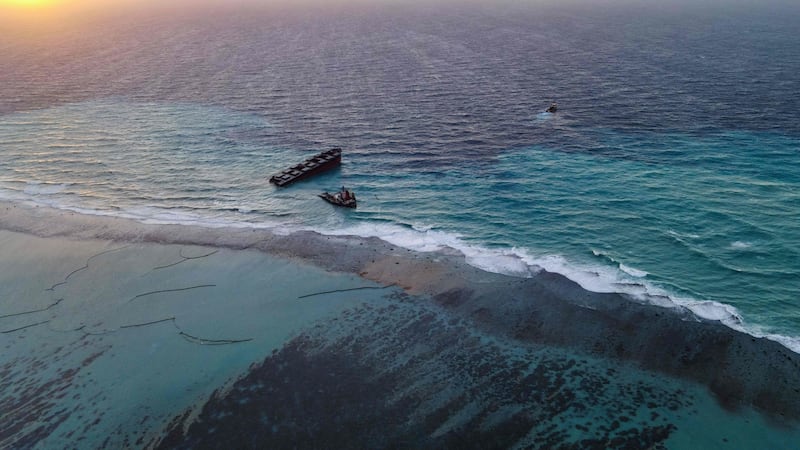International experts and thousands of local volunteers were making frantic efforts on Sunday to protect Mauritius’s pristine beaches and rich marine wildlife after hundreds of tonnes of oil was dumped into the sea by a Japanese tanker in what some scientists called the country’s worst ecological disaster.
The MV Wakashio, which ran aground almost three weeks ago, split in half on Saturday afternoon as Mauritian authorities said poor sea conditions made the removal of the remaining oil on the ship risky.
The Panama-flagged tanker was carrying more than 4,000 tonnes of heavy oil, lubricants and diesel from China to Brazil. Between 800 and 1,200 tonnes was thought to have leaked into the sea, with the rest being pumped out by salvage experts.
"In view of the rough sea condition, the salvage company . . . has informed us that it cannot carry on with the pumping of the remaining oil," the Mauritius National Crisis Committee said in a statement.
Scientists say the full impact of the spill is still unclear, but the oil has already reached exceptional zones of marine life, including the Ile aux Aigrettes nature reserve and the Blue Bay Marine Park, a unique coastal wetland recognised for the diversity of its coral and fish species, as well as for the endangered green turtle.
Satellite images also show contamination spreading northward along the coastline.

“This oil spill occurred in one of, if not the most, sensitive areas in Mauritius,” Vassen Kauppaymuthoo, and oceanographer and environmental engineer, told Reuters by telephone from the island, where he was surveying the disaster. “We are talking of decades to recover from this damage, and some of it may never recover.”
The wildlife at risk include the seagrasses blanketing sand in the shallow waters, clownfish darting around coral reefs, mangrove trees corralling the coastline with their tangled root systems and the critically endangered pink pigeon, endemic to the island.
Giant tortoises live in a nature reserve on the Ile aux Aigrettes, where there is also a scientific research station.
‘Poisonous shock’
The spill brings "a massive poisonous shock to the system," said Adam Moolna, an environmental scientist from Mauritius who lectures at Keele University in the UK. "This oil will have cascading effects across the webs of life."
Thousands of volunteers, many smeared from head to toe in black sludge, ignored official instructions to stay away and strung together miles of improvised floating barriers made of straw in a desperate attempt to hold back the oily tide.
"We have had to fully equip our front line staff . . . Many persons have been wading into the oil spilled waters with only thongs and wearing shorts and it is extremely dangerous. A couple of hours exposed to fumes can cause headaches, nose and eye burns and even dizziness," said Jean Hugues Gardenne, of the Mauritian Wildlife Foundation (MWF), an independent NGO.
Booms made of sugar-cane leaves, plastic bottles and hair, which people have been voluntarily cutting off, have been floated on the sea to prevent the oil spill spreading, said Romina Tello, an island resident.
“Hair absorbs oil, but not water,” Tello, founder of Mauritius Conscious, an eco-tourism agency, said.
Covid-19
Tourism generated 63 billion rupees (€1.34 billion) for the Mauritian economy last year. The industry had already been badly hit by the Covid-19 pandemic.
Mauritius shut its borders on March 19th and has had only 344 cases of Covid-19, of which 332 have recovered and 10 have died. The country is still closed to international air travel. In May, the central bank said that in the past two months alone, the nation had lost 12 billion rupees in foreign exchange due to the fall in tourism.
The disaster comes after years of work to restore the natural wildlife and plants on the affected coastline. “The conservation work carried out on Ile aux Aigrettes for nearly four decades is at stake,” said Gardenne.
“The impact of this spill will definitely be felt for a much longer time to come. The local communities relying on fishing to earn a living are heavily affected . . . Mangroves, corals and marine ecosystem are affected and the impact on tourism, a pillar of our economy, will be huge.”
There was anger at the government's slow response. Within days of the wreck, activists found dead eels, starfish, seabirds and crabs coated with oil but the prime minister, Pravind Jugnauth, only declared a state of emergency on Friday.
Birthday party
Members of the crew have reportedly told police that the 58-year-old captain of the tanker was celebrating a birthday party onboard and was not on the bridge at the time of the collision. Local coast guards made several attempts to contact the tanker before it ran aground on July 25th.
Conservationists were also anxious about oil washing into mangrove forests, where roots serve as nurseries for fish. Oil also could sink into sediments around mangroves, where it could smother molluscs, crabs and fish larvae. Birds nesting in the mangroves, or migrating via nearby mudflats, are also vulnerable. Ingesting oil can make it hard for birds to fight disease or even to fly. Corals are likely to be damaged when the heavier particles in the oil settle on them.
The owners of the tanker have said they are “deeply conscious of [their] responsibility as a party directly involved in the case”.
"Regarding compensation, we plan to deal with the issue sincerely based on applicable laws," said Kiyoaki Nagashiki, president of Nagashiki Shipping, the head of the Okayama-based company, in a statement released on Thursday. – Guardian













